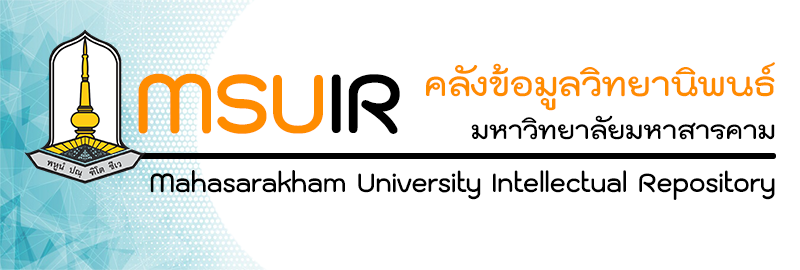Please use this identifier to cite or link to this item:
http://202.28.34.124/dspace/handle123456789/2659Full metadata record
| DC Field | Value | Language |
|---|---|---|
| dc.contributor | Rattiya Thungjan | en |
| dc.contributor | รัตติยา ทุงจันทร์ | th |
| dc.contributor.advisor | Piyaporn Saensouk | en |
| dc.contributor.advisor | ปิยะพร แสนสุข | th |
| dc.contributor.other | Mahasarakham University | en |
| dc.date.accessioned | 2025-05-07T10:20:14Z | - |
| dc.date.available | 2025-05-07T10:20:14Z | - |
| dc.date.created | 2024 | |
| dc.date.issued | 20/5/2024 | |
| dc.identifier.uri | http://202.28.34.124/dspace/handle123456789/2659 | - |
| dc.description.abstract | This research studied a propagation protocol of Kaempferia sisaketensis Picheans. & Koonterm which is a rare and endemic plant of Northeast of Thailand using plant tissue culture techniques. Microshoot (1 cm long) of K. sisaketensis were cultured on Murashige and Skoog (MS) supplemented with various concentrations of cytokinin (BA, Kinetin, and TDZ) and auxin (NAA) for eight weeks. The results show that culturing the microshoot of K. sisaketensis on MS medium supplemented with 1 mg/l Kinetin produced the highest number of shoots, which is 5.30 shoots/explant. For root induction, the results show that the highest number of roots were 14.50 roots/explant when microshoots of K. sisaketensis was cultured on MS medium augmented with 2 mg/l Kinetin and 1 mg/l NAA. After transferring complete plantlets of K. sisaketensis to pots containing different types of plant materials under greenhouse conditions for eight weeks, the best survival rate was 100% when transplanted in sand. Phytochemical profile were investigated by total phenolic contents (TPC), total flavonoid contents (TFC) and antioxidant activity of conventionally propagated plants, in vitro derived plantlets for one year and micropropagated plants of K. sisaketensis. The results showed that the leaves of K. sisaketensis from conventionally propagated plants presenting the highest values of TPC and TFC were 30.53 mg GAE/g DW and 24.00 mg RE/g DW, respectively. Antioxidant activity (DPPH assay, FRAP assay and ABTS assay) were measured. Leaves of K. sisaketensis from natural conditions showed the best inhibition rate of 95.08% by DPPH assay, 62.24 mg FeSO4/g DW by FRAP assay and 99.92% by ABTS assay. The type and amount of phenolic acid and flavonoid compounds were analyzed using High Performance Liquid Chromatography (HPLC). Four phenolic acid (gallic acid, vanillic acid, p-coumaric and cinnamic acid) and two flavonoid contents (rutin and kaempferol) were found. This research is the first report on tissue culture and phytochemical profile of K. sisaketensis. This study can be used to propagate and in vitro conservation of K. sisaketensis from extinction. | en |
| dc.description.abstract | งานวิจัยนี้ศึกษาวิธีการขยายพันธุ์เปราะหูกระต่าย (Kaempferia sisaketensis Picheans. & Koonterm) ซึ่งมีสถานภาพเป็นพืชหายาก พืชถิ่นเดียวที่พบในภาคตะวันออกเฉียงเหนือของประเทศไทยด้วยเทคนิคการเพาะเลี้ยงเนื้อเยื่อพืช นำต้นอ่อนเปราะหูกระต่ายขนาด 1 เซนติเมตร มาเพาะเลี้ยงบนอาหารสังเคราะห์สูตร Murashige และ Skoog (MS) ที่เติมฮอร์โมนไซโทไคนิน (BA, Kinetin และ TDZ) และฮอร์โมนออกซิน (NAA) ที่ระดับความเข้มข้นแตกต่างกัน เพาะเลี้ยงเป็นเวลา 8 สัปดาห์ ผลการศึกษาพบว่าต้นอ่อนเปราะหูกระต่ายที่เพาะเลี้ยงในอาหารสูตร MS ที่เติม Kinetin ความเข้มข้น 1 มิลลิกรัม/ลิตร มีจำนวนยอดเฉลี่ยมากที่สุด 5.30 ยอด/ชิ้นส่วนพืช เมื่อเพาะเลี้ยงต้นอ่อนเปราะหูกระต่ายในอาหารสูตร MS ที่เติม Kinetin ความเข้มข้น 2 มิลลิกรัม/ลิตร ร่วมกับ NAA ความเข้มข้น 1 มิลลิกรัม/ลิตร สามารถชักนำให้เกิดรากเฉลี่ยมากที่สุด 14.50 ราก/ชิ้นส่วนพืช ต้นอ่อนเปราะหูกระต่ายที่สมบูรณ์เมื่อย้ายออกปลูกในเรือนเพาะชำในวัสดุปลูกที่แตกต่างกัน เป็นเวลา 8 สัปดาห์ พบว่าเมื่อย้ายปลูกในดินทรายมีอัตราการรอดชีวิตสูงสุด 100% ศึกษาสารพฤกษเคมีของต้นเปราะหูกระต่ายที่เจริญเติบโตในสภาพธรรมชาติ พืชที่เพาะเลี้ยงในหลอดทดลองย้ายออกปลูกในเรือนเพาะชำ 1 ปี และพืชที่เพาะเลี้ยงในหลอดทดลอง พบว่าใบเปราะหูกระต่ายที่เจริญเติบโตในสภาพธรรมชาติ มีปริมาณฟีนอลิกทั้งหมดสูงสุด 30.53 มิลลิกรัมสมมูลกรดแกลลิกต่อกรัมน้ำหนักแห้ง และมีปริมาณฟลาโวนอยด์ทั้งหมดสูงสุด 24.00 มิลลิกรัมสมมูลรูทินต่อกรัมน้ำหนักแห้ง วิเคราะห์ฤทธิ์ต้านอนุมูลอิสระด้วยวิธี DPPH assay, FRAP assay และ ABTS assay พบว่าใบที่เจริญเติบโตในสภาพธรรมชาติ มีเปอร์เซ็นต์การยับยั้งอนุมูลอิสระ DPPH 95.08 เปอร์เซ็นต์ มีฤทธิ์ต้านอนุมูลอิสระ 62.64 มิลลิกรัมสมมูลเฟอร์รัสซัลเฟตต่อกรัมน้ำหนักแห้ง และมีเปอร์เซ็นต์การยับยั้งอนุมูลอิสระ ABTS 99.92 เปอร์เซ็นต์ วิเคราะห์ชนิดและปริมาณของกรดฟีนอลิกและสารประกอบฟลาโวนอยด์ด้วยเทคนิคโครมาโทกราฟีของเหลวสมรรถนะสูง (HPLC) พบกรดฟีนอลิก 4 ชนิด ได้แก่ กรดแกลลิก กรดวานิลลิก กรดคูมาริก และกรดซินนามิก และพบสารประกอบฟลาโวนอยด์ 2 ชนิด ได้แก่ รูทิน และ แคมพ์เฟอรอล การศึกษานี้เป็นรายงานการเพาะเลี้ยงเนื้อเยื่อและพฤกษเคมีในเปราะหูกระต่ายเป็นครั้งแรก จากการศึกษานี้สามารถใช้ในการขยายพันธุ์และอนุรักษ์พันธุ์เปราะหูกระต่ายไม่ให้สูญพันธุ์ | th |
| dc.language.iso | th | |
| dc.publisher | Mahasarakham University | |
| dc.rights | Mahasarakham University | |
| dc.subject | การเพาะเลี้ยงเนื้อเยื่อพืช | th |
| dc.subject | การย้ายออกปลูก | th |
| dc.subject | พืชหายาก | th |
| dc.subject | พฤกษเคมี | th |
| dc.subject | เปราะหูกระต่าย | th |
| dc.subject | Plant tissue culture | en |
| dc.subject | Transplantation | en |
| dc.subject | Rare plant | en |
| dc.subject | Phytochemical profile | en |
| dc.subject | Kaempferia sisaketensis Picheans. & Koonterm | en |
| dc.subject.classification | Agricultural and Biological Sciences | en |
| dc.subject.classification | Agriculture,forestry and fishing | en |
| dc.subject.classification | Chemistry | en |
| dc.title | In Vitro Propagation and Phytochemical Profiles of Kaempferia sisaketensis Picheans. & Koonterm | en |
| dc.title | การขยายพันธุ์ในหลอดทดลองและพฤกษเคมีของเปราะหูกระต่าย | th |
| dc.type | Thesis | en |
| dc.type | วิทยานิพนธ์ | th |
| dc.contributor.coadvisor | Piyaporn Saensouk | en |
| dc.contributor.coadvisor | ปิยะพร แสนสุข | th |
| dc.contributor.emailadvisor | piyaporn.sa@msu.ac.th | |
| dc.contributor.emailcoadvisor | piyaporn.sa@msu.ac.th | |
| dc.description.degreename | Master of Science (M.Sc.) | en |
| dc.description.degreename | วิทยาศาสตรมหาบัณฑิต (วท.ม.) | th |
| dc.description.degreelevel | Master's Degree | en |
| dc.description.degreelevel | ปริญญาโท | th |
| dc.description.degreediscipline | Department of Biology | en |
| dc.description.degreediscipline | ภาควิชาชีววิทยา | th |
| Appears in Collections: | The Faculty of Science | |
Files in This Item:
| File | Description | Size | Format | |
|---|---|---|---|---|
| 64010257002.pdf | 4.81 MB | Adobe PDF | View/Open |
Items in DSpace are protected by copyright, with all rights reserved, unless otherwise indicated.

